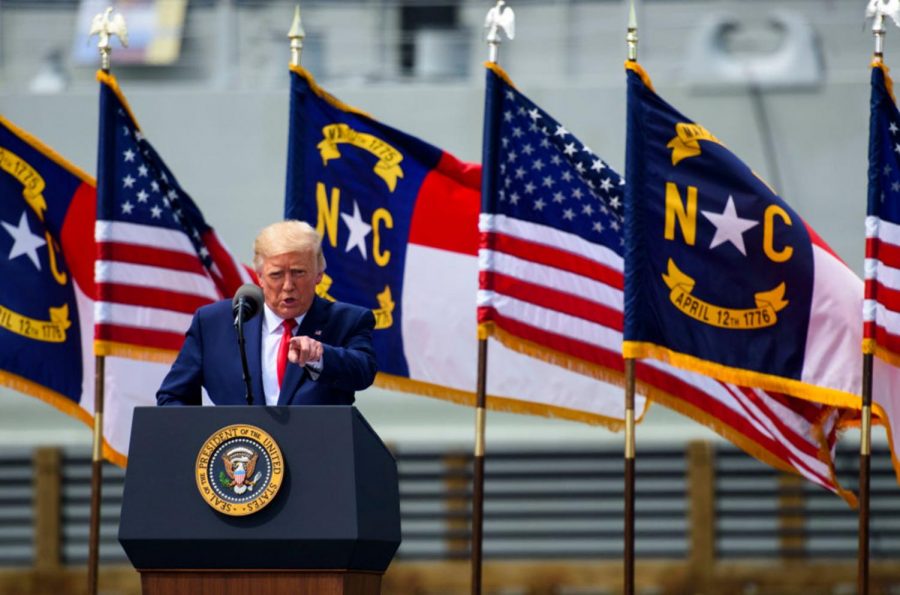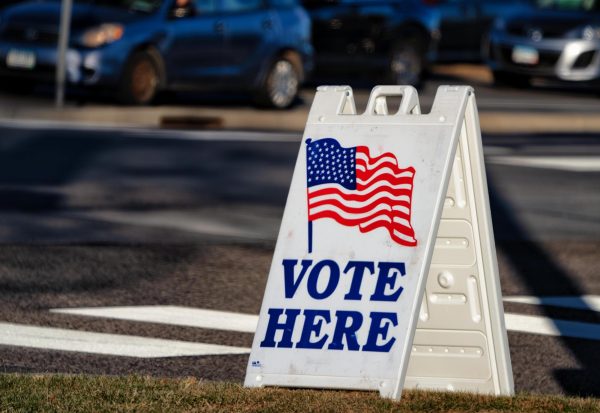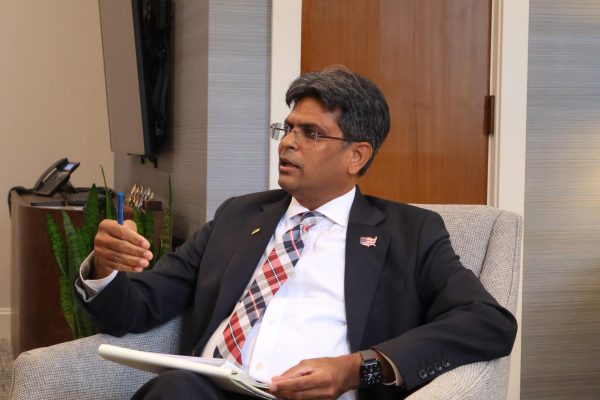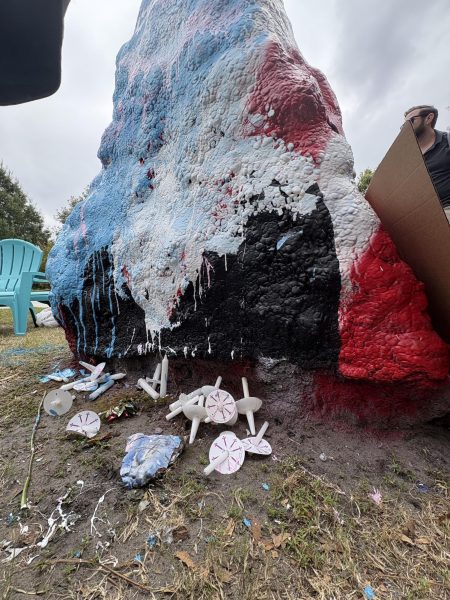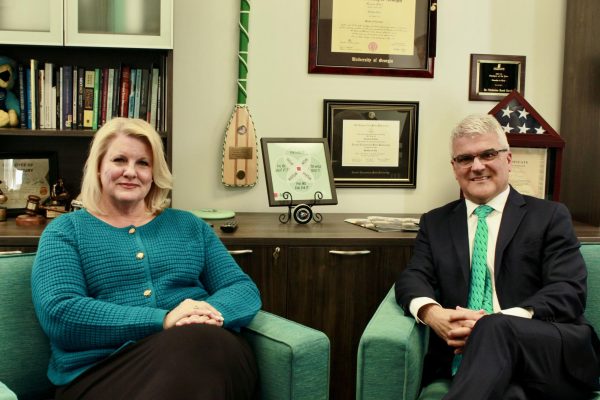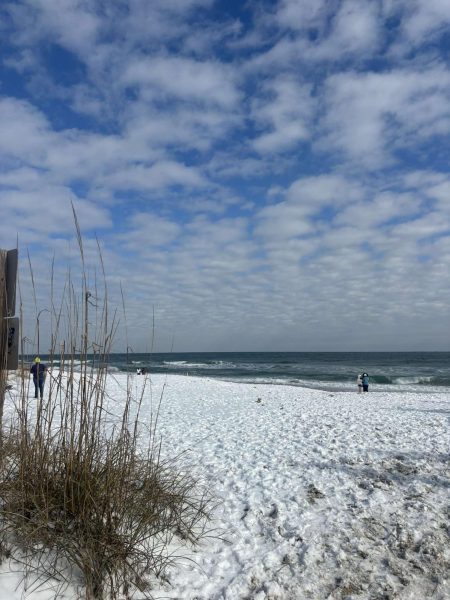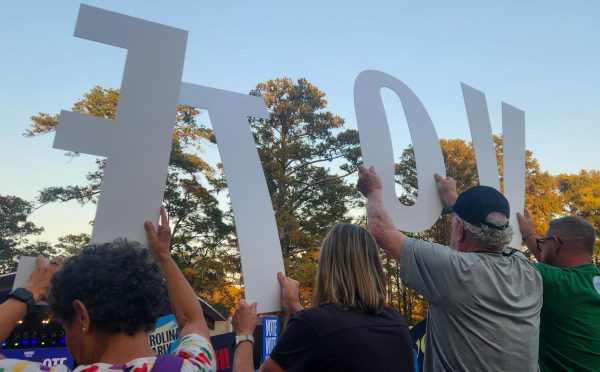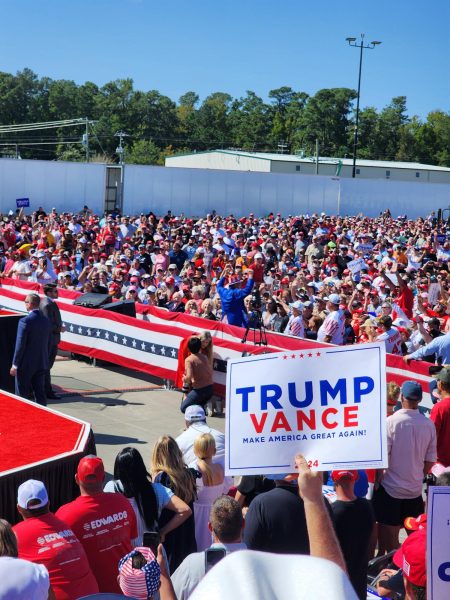Wilmington named first World War II Heritage City
Tribune News Service
President Donald Trump speaks to a small crowd outside the USS North Carolina on Sept. 2, 2020 in Wilmington, North Carolina. President Donald Trump visited the port city for a brief ceremony designating Wilmington as the nation’s first WWII Heritage City. The title is in honor of the area’s efforts during WWII.(Photo by Melissa Sue Gerrits/Getty Images/TNS)
This past week saw the arrival of President Donald Trump in Wilmington, NC. On Sept. 2. Trump visited the Cape Fear region to celebrate Wilmington being named the first World War II Heritage City.
Wilmington’s pursuit for this title was a twelve-year process that was proposed, developed and led by the World War II Wilmington Home Front Heritage Coalition. The Coalition was co-founded by retired U.S Navy Captain Wilbur Jones and serves to “identify, preserve, and interpret rich WWII history.” This is an all-volunteer, 501(c)(3) organization that is supported by numerous community leaders, local organizations and elected officials. Due to the initiative that Wilmington took, America now has a WWII Heritage Cities Program.
To receive the honor of being named a WWII Heritage City, cities must have made “major wartime contributions” and “have worked actively to preserve the military legacy,” noted a WECT article. The 1961 arrival of the USS North Carolina in Wilmington only began the long journey to protect and preserve the rich history of Wilmington’s war contributions.
To gain more insight into how Wilmington received this great honor, The Seahawk reached out to Dr. Taylor Fain, a history professor at UNC Wilmington (UNCW) and a former U.S Department of State historian.
He was able to provide immense information on both N.C.’s as well as Wilmington’s contributions to the war. Southeastern N.C. was a major part of the war effort, as around 150,000 American servicemen and women were stationed at Fort Bragg, Camp Lejeune, the Cape Fear Region or at many of the other smaller sites. Two million out of the fifteen million Americans who enlisted following the events of Pearl Harbor were trained in N.C.
Between 1942 and 1945, Wilmington’s North Carolina Shipbuilding Company produced more than 250 ships and employed more than 21,000 workers. Dr. Fain mentioned that most of the ships were the famous “Liberty Ships”, which carried two-thirds of U.S. cargo during the war. These ships significantly assisted with the Allied war effort as merchant ships. Due to the influx of shipyard workers and numerous others, Wilmington’s population nearly doubled from the 35,000 prior to the war.
Wilmington also served as the “social hub” for the servicemen and women on weekends, and was home to nine United Service Organization (USO) clubs. The Hannah Block Historic USO/Community Arts Center was an extremely popular USO club during the war, and has since been fully restored. Dr. Fain also made sure to mention that there was a Prisoner of War (POW) camp on the corner of what is now Shipyard Boulevard and Carolina Beach Road.
“For many years, Wilmington has had an active community of World War II veterans who met regularly in a group called World War II Remembered,” said Dr. Fain. “Their numbers are dwindling as time passes, and it is very gratifying to know that the president of the United States is acknowledging the critical role they played in defending our nation and the free world from fascism.”
This event was quite an honor for the 25 veterans who were in attendance as well as the Wilmington community. The president spoke in front of the USS North Carolina, better known to N.C. residents as “The Battleship.” During his remarks, he briefly referenced the recent movements to remove Confederate monuments throughout the country.
“With this designation, we proudly declare that, in America, we don’t tear down the past, we celebrate our heroes, we cherish our heritage, we preserve our history, and we build a future,” said the President.
During the speech, the president spoke of the Democratic presidential nominee Joe Biden while honoring 97-year-old Hershel “Woody” Williams, who was awarded the Medal of Honor for his war contributions.
“I promised him I would not tell that he’s 97 years old. I promised,” said the president. “And I’ll tell you, he’s 100 percent sharp. He’s 100 percent sharp. I know a 78-year-old that’s not so sharp, and he’s 97, and he’s 100 percent because it has nothing to do with that. Seventy-eight is young. Depends who’s 78, that’s all.”
While the visit was to formally honor Wilmington as the first World War II Heritage City, it also served as an unofficial campaign stop. City leaders expected between 500 and 800 people to welcome the president on the Wilmington International Airport tarmac. There was a smaller number of invitation-only guests at the Battleship ceremony, where the president gave his speech. In both locations, crowds were seen as not social distancing or wearing masks, despite our current state guidelines.
Biden also released a statement prior to the event, citing the president’s COVID-19 response.
“President Trump likes to call himself a wartime president, but the reality is that North Carolinians are still suffering because he surrendered to COVID-19 long ago. He abandoned North Carolinians in their moment of need, and his failure of leadership has cost over 2,700 lives.”
North Carolina is a “battleground” state this upcoming election, as Trump won here in 2016. He has made 12 visits to North Carolina so far and plans to do more as the election draws closer.
“Wilmingtonians have worked for years to make certain our city’s contributions to the war effort were properly recognized,” said Dr. Fain. “Wilmington is a great case study of how the Second World War changed the fabric of everyday life for average Americans on the homefront.”



